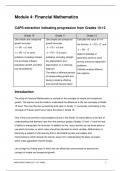Summary
Summary Financial Mathematics notes and examples CAPS Grades 10-12
- Course
- Institution
Financial Mathematics notes and examples CAPS Grades 10-12. NO time to revise Financial math's in Pure math's in your matric year, simple use these easy and self help notes to ace that dreading section in your exam. The following topics make up each of the TWO exam papers that you write at the ...
[Show more]



